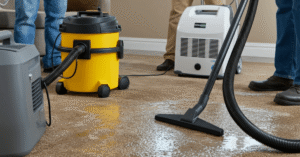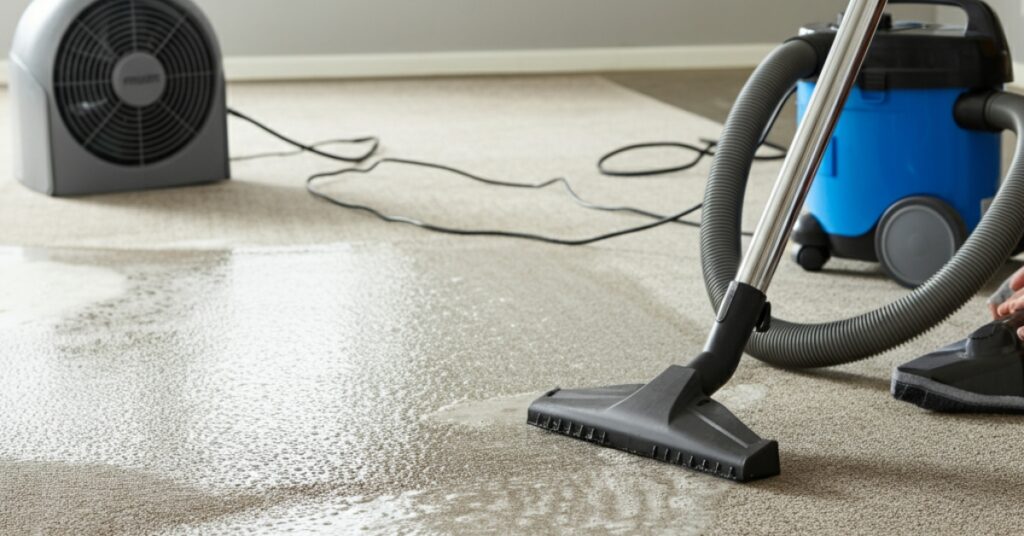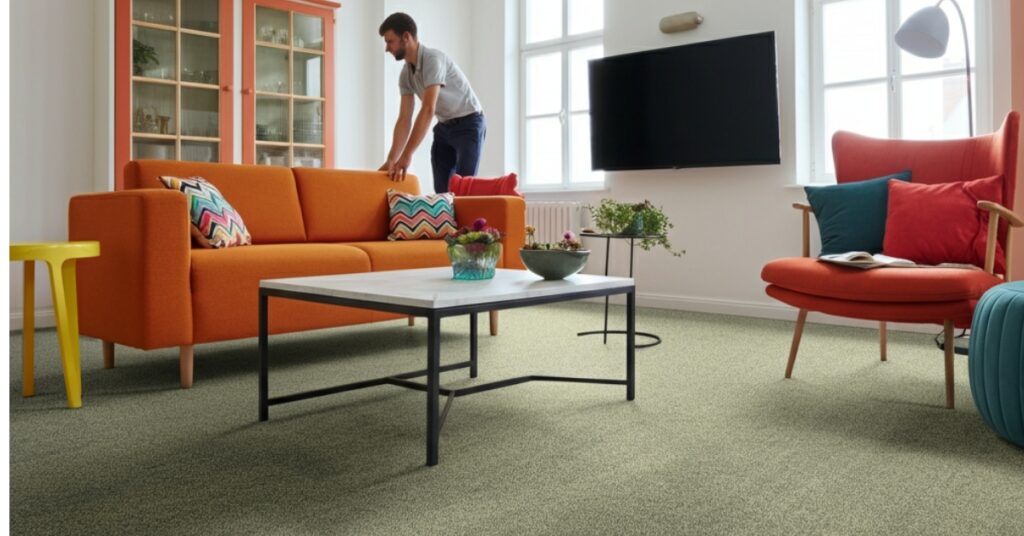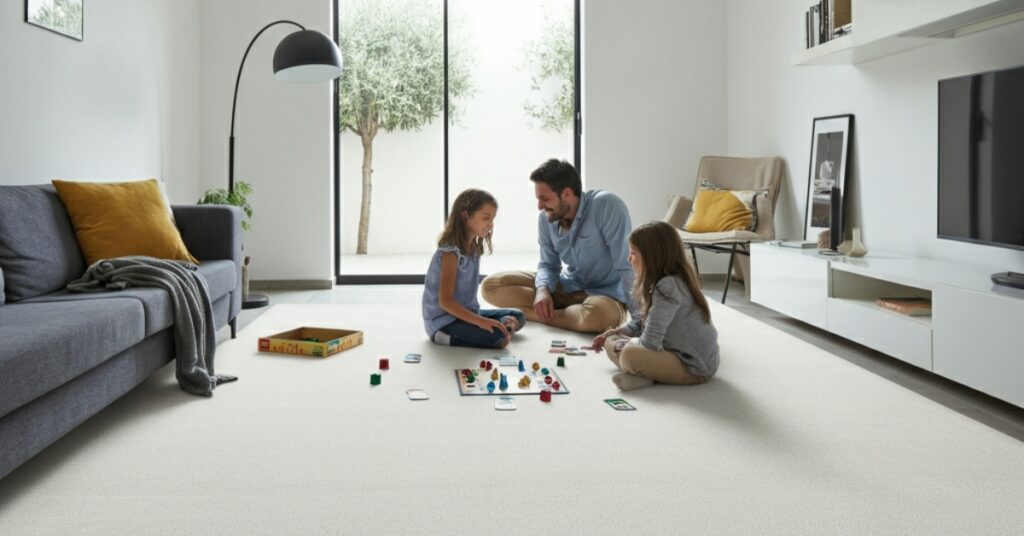As an Amazon Associate, I earn from qualifying purchases.
Finding a mysterious wet spot on your carpet can be concerning and frustrating. Why is my carpet wet in one spot when there’s no obvious source of moisture? Several factors can create localized moisture problems that affect specific carpet areas while leaving surrounding sections completely dry.
Understanding these causes helps you address the issue quickly and prevent potential damage to your flooring. Moreover, identifying the source early can save you from expensive carpet replacement or extensive water damage repairs. This guide explores the most common reasons for isolated carpet wetness and provides practical solutions for each situation.
Water Leaks Behind Walls Create Localized Wet Spots
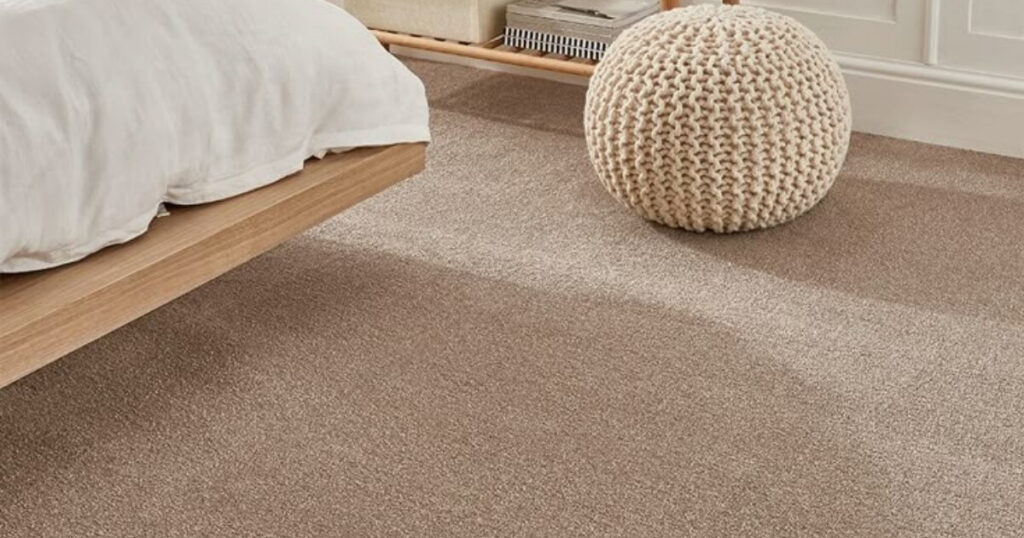
Hidden plumbing leaks represent one of the most common causes of mysterious carpet wet spots. Water pipes running behind walls or under floors can develop small leaks that seep through building materials and emerge at specific carpet locations. These leaks often go undetected for weeks or months before becoming visible on carpet surfaces.
Wall-mounted fixtures like toilets, sinks, and washing machines frequently develop connection leaks that travel through subflooring. Additionally, older homes with aging plumbing systems experience pipe deterioration that creates pinhole leaks in unexpected locations. The moisture follows the path of least resistance through building materials until it reaches your carpet in seemingly random spots.
Identifying Plumbing-Related Moisture
Check areas around bathroom fixtures, kitchen appliances, and laundry equipment first when you discover wet carpet spots. Run your hands along baseboards near the wet area to detect moisture or soft spots in drywall. Furthermore, monitor water bills for unexpected increases that might indicate hidden leaks consuming water continuously.
Professional plumbers use moisture meters and thermal imaging cameras to locate hidden leaks without destructive investigation. However, you can perform basic checks by turning off all water fixtures and monitoring your water meter for continued movement. Additionally, food coloring in toilet tanks can reveal slow leaks that might not be immediately obvious through visual inspection.
Appliance Leaks Cause Targeted Carpet Damage
Household appliances with water connections commonly develop leaks that affect specific carpet areas. Washing machines experience supply line failures, pump leaks, and drain overflow problems that send water directly onto nearby flooring. Similarly, water heaters can develop tank leaks or connection problems that create isolated moisture problems.
Dishwashers frequently leak from door seals, supply connections, or drain lines that route water under adjacent flooring. Refrigerators with ice makers or water dispensers can experience supply line failures that leak water onto kitchen carpets. Moreover, air conditioning units produce condensation that can overflow drain pans and affect carpet areas beneath vents or near equipment locations.
Preventive Appliance Maintenance
Regular inspection of water supply lines and drain connections helps prevent appliance-related carpet damage. Check washing machine hoses every six months for cracks, bulges, or loose connections that indicate impending failure. Furthermore, replace rubber supply lines every five years regardless of visible condition to prevent unexpected failures.
Monitor appliance operation for unusual sounds, water pooling, or performance changes that suggest internal problems. Keep absorbent mats under washing machines, water heaters, and other water-using appliances to catch small leaks before they reach carpet. Additionally, install water leak detection devices near major appliances to provide early warning of moisture problems.
HVAC System Issues Create Moisture Problems
Heating and cooling systems can generate localized moisture that affects specific carpet areas through several mechanisms. Condensation from air conditioning ducts or equipment can drip onto carpet when insulation fails or drain systems malfunction. Additionally, humidity control problems can create conditions where moisture condenses on carpet surfaces in specific locations.
Ductwork leaks allow conditioned air to escape into wall cavities or under floors where temperature differences create condensation. This moisture eventually migrates through building materials and emerges on carpet surfaces. Furthermore, improperly sized HVAC systems create humidity imbalances that can cause condensation problems in specific rooms or areas.
HVAC Moisture Solutions
Inspect ductwork in crawl spaces or basements for visible condensation, water stains, or dripping. Check drain pans under air conditioning units for proper drainage and clean blocked lines that might cause overflow. Moreover, ensure proper insulation around ducts to prevent temperature-related condensation in unconditioned spaces.
Professional HVAC technicians can evaluate system sizing, humidity control, and ventilation adequacy to prevent moisture-related problems. Regular filter changes improve system efficiency and reduce humidity problems that contribute to condensation. Additionally, consider installing whole-house dehumidifiers in climates with persistent humidity problems that affect indoor air quality.
Pet Accidents Target Specific Areas
Animals often choose specific carpet locations for elimination, creating recurring wet spots that might initially seem mysterious. Dogs and cats can develop preferences for particular areas due to scent marking, texture preferences, or territorial behaviors. Even well-trained pets might have accidents during illness, stress, or changes in household routine.
Previous pet accidents leave scent markers that encourage repeated use of the same carpet areas. Standard cleaning methods often fail to eliminate odors that pets can detect even when humans cannot smell them. Additionally, elderly or sick animals might lose bladder control and consistently wet the same convenient areas near their sleeping or feeding locations.
Effective Pet Accident Treatment
Enzymatic cleaners specifically designed for pet accidents break down organic compounds that create persistent odors. These products require adequate contact time to work effectively, so avoid immediate removal after application. Furthermore, treat a larger area than the visible stain to ensure complete odor elimination that prevents repeat incidents.
Black lights can reveal old pet accidents that aren’t visible under normal lighting conditions. Professional carpet cleaners have specialized equipment and products that can eliminate deep-set pet odors that resist home treatment methods. Moreover, consider temporary barrier methods like furniture placement or pet gates to prevent access to problem areas during training or treatment periods.
Foundation Issues Allow Moisture Infiltration
Basement or crawl space moisture can migrate upward through concrete foundations and subflooring to affect specific carpet areas. Foundation cracks, inadequate waterproofing, or grading problems allow water to accumulate in specific locations beneath your home. This moisture travels through building materials and eventually emerges on carpet surfaces in predictable patterns.
Poor drainage around foundation walls creates hydrostatic pressure that forces moisture through concrete and affects overlying flooring. Additionally, basement humidity problems can affect carpet in rooms directly above moisture-prone areas. Spring thaws and heavy rainfall often worsen foundation-related moisture problems that affect indoor carpet conditions.
Foundation Moisture Prevention
Improve exterior drainage by ensuring proper grading that slopes away from foundation walls. Clean gutters and extend downspouts to direct water away from the building perimeter. Furthermore, seal foundation cracks and apply waterproofing treatments to prevent moisture infiltration from exterior sources.
Interior basement moisture control includes proper ventilation, dehumidification, and vapor barriers that prevent upward moisture migration. Professional moisture testing can identify problem areas before they affect upper-level flooring. Additionally, consider installing interior drainage systems in basements with persistent moisture problems that resist exterior treatment methods.
Roof Leaks Create Distant Carpet Damage
Roof leaks don’t always appear directly below the damaged area due to water traveling along structural members before dripping onto surfaces. A roof leak in one area might cause carpet wetness in a completely different room as water follows rafters, pipes, or electrical conduits. This delayed appearance often makes roof leaks difficult to identify and locate.
Ice dams, missing shingles, or flashing failures allow water to enter building structures where it travels unpredictable paths. Additionally, gradual roof deterioration can create slow leaks that don’t become obvious until significant moisture accumulation affects interior surfaces. Seasonal weather changes often worsen roof-related problems that create sporadic carpet moisture issues.
Roof Leak Detection Methods
Inspect attic spaces during and immediately after rainfall to identify active leaks before they affect carpet. Look for water stains, wet insulation, or dripping that indicates roof penetration problems. Furthermore, check around roof penetrations like vents, chimneys, and satellite dishes where flashing might fail and allow water entry.
Professional roofing contractors use moisture detection equipment to locate leak sources that aren’t immediately obvious through visual inspection. Document leak locations with photos and measurements to help contractors identify and repair specific problem areas. Moreover, consider temporary interior protection like buckets or tarps to prevent carpet damage while arranging permanent roof repairs.
Temperature Changes Create Condensation
Significant temperature differences between indoor and outdoor environments can cause condensation on carpet surfaces in specific locations. This typically occurs near exterior walls, windows, or doors where temperature variations are most pronounced. Additionally, poor insulation or air sealing allows cold surfaces to create condensation when warm, humid air contacts them.
Single-pane windows and poorly insulated walls create cold surfaces that cause water vapor to condense and potentially drip onto adjacent carpet areas. Moreover, thermal bridging through building materials can create specific spots where condensation consistently occurs during certain weather conditions. These problems often worsen during extreme temperature periods or high humidity conditions.
Condensation Control Strategies
Improve insulation around windows, doors, and exterior walls to reduce temperature differences that cause condensation. Install storm windows or replace single-pane windows with energy-efficient alternatives that resist condensation formation. Furthermore, ensure adequate ventilation to remove humid air that contributes to condensation problems throughout your home.
Monitor indoor humidity levels and use dehumidifiers when necessary to reduce moisture available for condensation. Ceiling fans can improve air circulation and prevent stagnant conditions that promote condensation in specific areas. Additionally, weather stripping and caulking around windows and doors reduces air leaks that contribute to temperature-related moisture problems.
Want to go beyond the basics? This guide dives deeper: Wet Carpet Not Drying?
Frequently Asked Questions
1. How quickly should I dry wet carpet spots?
Dry carpet moisture within 24-48 hours to prevent mold growth and permanent damage. Use fans, dehumidifiers, and absorbent materials to accelerate drying.
2. Can I use regular fans to dry wet carpet?
Yes, regular fans help dry wet carpet by improving air circulation. Position multiple fans to create cross-ventilation and accelerate moisture removal.
3. Should I pull up wet carpet to dry the padding?
Yes, severely wet carpet often requires pad removal and replacement. Carpet padding retains moisture and can develop mold if not properly dried.
4. How do I know if carpet moisture is from above or below?
Check basement or crawl space areas below the wet spot. Moisture from below typically affects larger areas, while overhead leaks create specific drip patterns.
5. Will wet carpet always develop mold problems?
No, prompt drying within 24-48 hours usually prevents mold growth. However, repeated moisture exposure increases mold risk significantly.
6. Can I prevent future carpet wet spots?
Yes, regular maintenance of plumbing, appliances, and roofing prevents most carpet moisture problems. Monitor high-risk areas and address issues promptly.
7. Do I need professional help for carpet moisture problems?
Professional help becomes necessary for extensive moisture, recurring problems, or suspected mold growth. DIY methods work for small, isolated incidents.
Take Action to Protect Your Flooring Investment
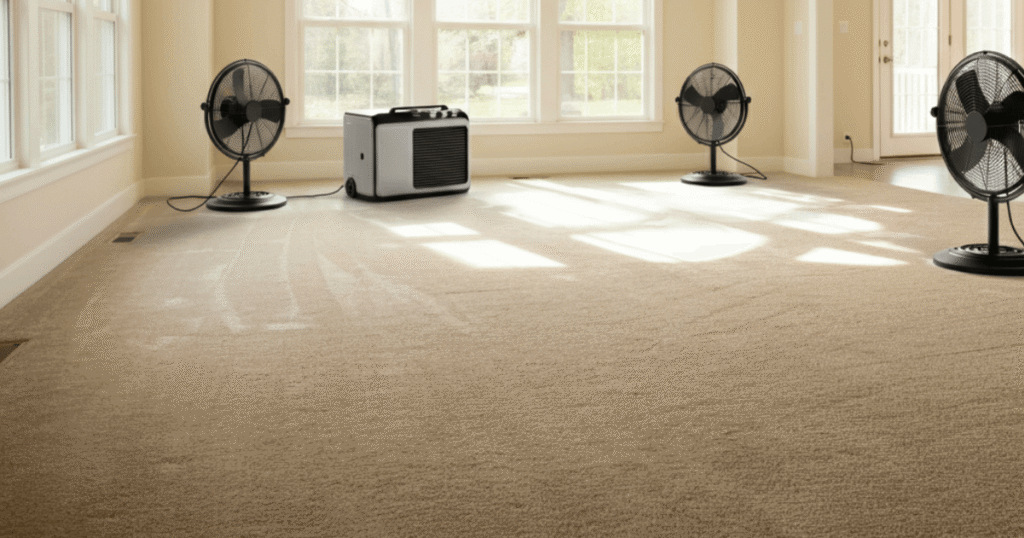
Discovering why your carpet is wet in one spot requires systematic investigation of common moisture sources. Quick identification and proper treatment prevent extensive damage and costly carpet replacement. Remember that persistent moisture problems often indicate underlying issues that need professional attention.
Regular maintenance of plumbing, appliances, and building systems prevents most carpet moisture problems. Address wet spots immediately to minimize damage and protect your home’s indoor air quality.
As an Amazon Associate, I earn from qualifying purchases.

